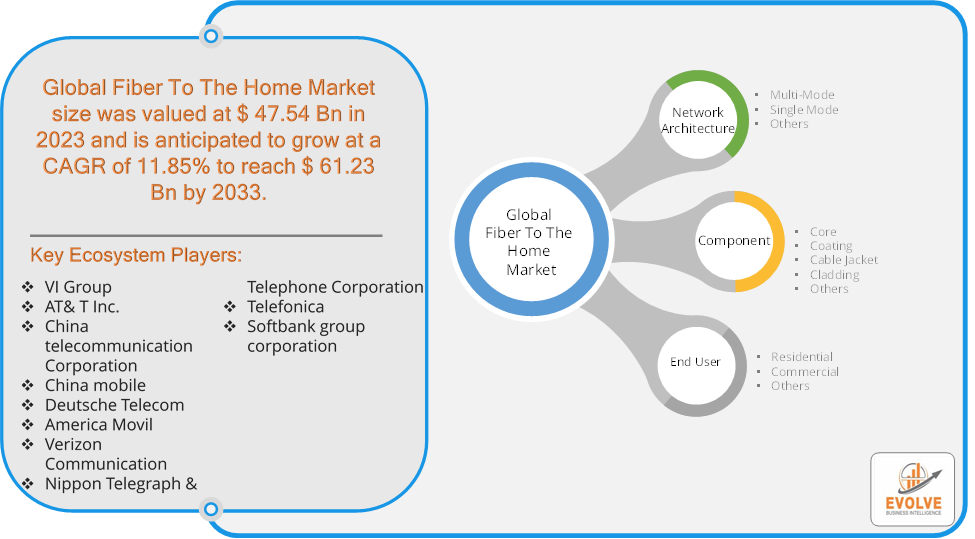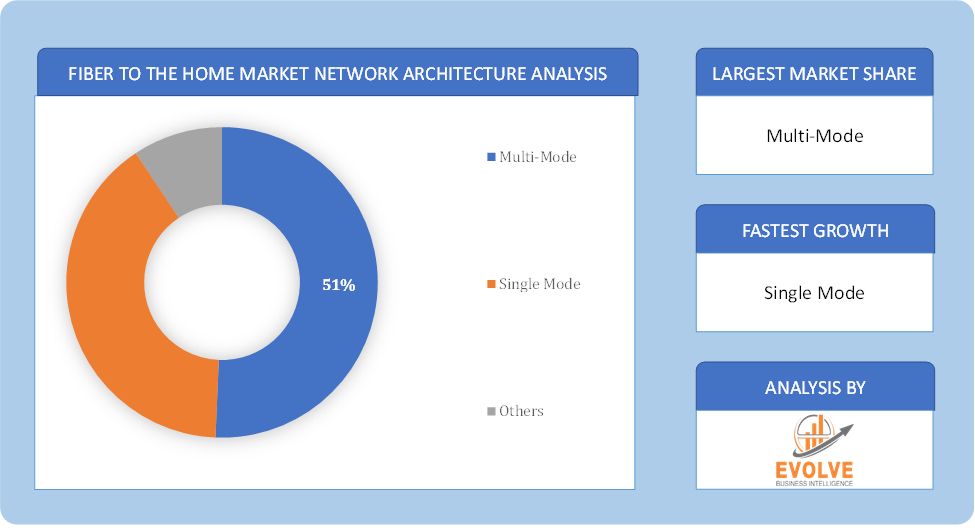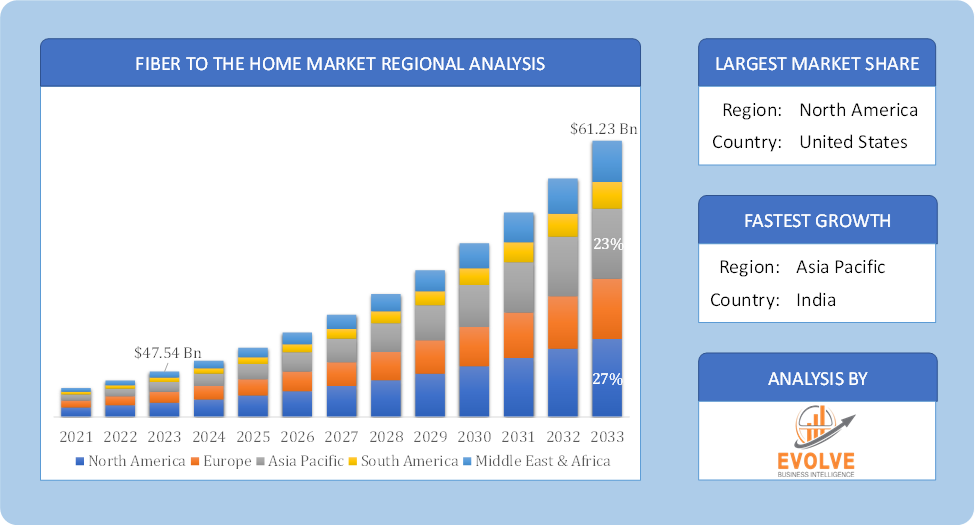Price range: $ 1,390.00 through $ 5,520.00
Fiber To The Home Market Research Report: Information By Network Architecture (Multi-Mode, Single Mode, Others), By Component (Core, Coating, Cable Jacket, Cladding, Others), By End-User (Residential, Commercial, Others), and by Region — Forecast till 2033
Page: 174
Description
Fiber To The Home Market Overview
The Fiber To The Home Market Size is expected to reach USD 61.23 Billion by 2033. The Fiber To The Home Market industry size accounted for USD 47.54 Billion in 2023 and is expected to expand at a compound annual growth rate (CAGR) of 11.85% from 2023 to 2033. The Fiber to the Home (FTTH) Market refers to the market segment focused on providing high-speed internet and telecommunications services directly to residential buildings via fiber optic cables. FTTH is part of the broader category of fiber to the premises (FTTP), which includes fiber connections to homes, businesses, and other buildings.
The FTTH market is characterized by rapid technological advancements, increasing consumer demand for high-speed connectivity, and significant investment in infrastructure development. While deployment costs pose a challenge, the long-term benefits in terms of speed, reliability, and capacity make it a promising market segment.
Global Fiber To The Home Market Synopsis
 COVID-19 Impact Analysis
COVID-19 Impact Analysis
The COVID-19 pandemic had a significant impact on the Fiber to the Home (FTTH) market. With lockdowns and social distancing measures in place, many people shifted to remote work and online education. This led to a surge in demand for reliable, high-speed internet connections, driving growth in the FTTH market. The pandemic accelerated the adoption of telehealth services, requiring robust internet connections that FTTH networks are well-suited to provide. The pandemic caused disruptions in global supply chains, affecting the availability of fiber optic cables and other necessary equipment. This led to delays in network deployment and expansion. Social distancing measures and lockdowns made it challenging for technicians to perform installations and maintenance, slowing down the rollout of FTTH services in some areas. The pandemic highlighted the importance of robust internet infrastructure, likely leading to sustained growth in the FTTH market as remote work and digital services continue to play a significant role post-pandemic.
Fiber To The Home Market Dynamics
The major factors that have impacted the growth of Fiber To The Home Market are as follows:
Drivers:
Ø Technological Advancements
Innovations in fiber optic materials and installation techniques have made FTTH deployments more efficient and cost-effective, encouraging wider adoption. FTTH networks can support multiple services (internet, TV, and telephone) over a single connection, making them an attractive option for service providers and consumers. The proliferation of smart home devices and IoT applications requires robust and high-speed internet connections, which FTTH networks can effectively support. As more households adopt smart home technologies, the demand for reliable internet connectivity increases, driving the growth of FTTH networks. Fiber optic networks are more energy-efficient than traditional copper-based networks, aligning with global sustainability goals.
Restraint:
- Perception of High Initial Investment Costs and Technological Complexity
The cost of laying fiber optic cables and building the necessary infrastructure is substantial, which can be a barrier for service providers, especially in regions with challenging terrain or low population density. The significant capital investment required for FTTH deployment can be a deterrent for smaller providers and limit the speed of network expansion. The technical expertise required for the installation and maintenance of fiber optic networks can be a constraint, particularly in regions with limited skilled labor. Integrating new FTTH networks with existing telecommunications infrastructure can pose technical challenges.
Opportunity:
⮚ Integration with Emerging Technologies
The convergence of FTTH with emerging technologies like 5G and the Internet of Things (IoT) offers opportunities to enhance connectivity and provide comprehensive solutions for smart homes and cities. FTTH can play a crucial role in smart city projects by providing the necessary infrastructure for advanced applications such as smart grids, traffic management, and public safety systems. The continued growth of video streaming, online gaming, and virtual reality applications increases the demand for high-bandwidth connections, driving the need for FTTH networks. As remote work and online education become more prevalent, there is an opportunity to cater to the demand for high-speed, reliable internet connectivity that supports these activities.
Fiber To The Home Market Segment Overview
 By Network Architecture
By Network Architecture
Based on Network Architecture, the market is segmented based on Multi-Mode, Single Mode and Others. The Multimode segment dominant the market. Multimode fiber is composed of many transit channels, or modes, when compared to single-mode fiber. This type consists of a relatively low-bandwidth core, usually with a diameter of either 62.5 or 50 microns. It is traditionally used for short distance transmissions such as between buildings in a corporate environment. Furthermore, it is more cost-effective than single-mode fiber, making it a popular choice for many applications.
By Component
Based on Component, the market segment has been divided into Core, Coating, Cable Jacket, Cladding and Others. The Cable Jacket segment dominant the market. The cable jacket is a critical aspect of the FTTH market. Its performance directly impacts the overall reliability and longevity of the fiber optic network. As the demand for high-speed internet continues to grow, the importance of cable jackets will only increase.
By End User
Based on End User, the market segment has been divided into Residential, Commercial and Others. The Commercial segment dominant the market. Fiber to the Home technology has become a reliable option to providing high-speed internet access to businesses. Organizations that require large amounts of data to be transferred, such as driverless cars, are increasingly becoming reliant on FTTH to keep operations running smoothly. By having FTTH, businesses also enjoy significant cost-savings, as the technology is more reliable, faster and more secure to use, thereby reducing IT and maintenance costs.
Global Fiber To The Home Market Regional Analysis
 Based on region, the global Fiber To The Home Market has been divided into North America, Europe, Asia-Pacific, the Middle East & Africa, and Latin America. North America is projected to dominate the use of the Fiber To The Home Market followed by the Asia-Pacific and Europe regions.
Based on region, the global Fiber To The Home Market has been divided into North America, Europe, Asia-Pacific, the Middle East & Africa, and Latin America. North America is projected to dominate the use of the Fiber To The Home Market followed by the Asia-Pacific and Europe regions.
Fiber To The Home North America Market
North America holds a dominant position in the Fiber To The Home Market. The FTTH market in North America is well-developed, driven by high demand for high-speed internet and strong investment from service providers. The region benefits from a competitive landscape, with major telecom companies expanding their fiber networks. Increasing remote work, online education, and the adoption of smart home technologies are key growth drivers in this region. Additionally, regulatory support and funding programs aimed at expanding broadband access in underserved areas contribute to market expansion.
Fiber To The Home Asia-Pacific Market
The Asia-Pacific region has indeed emerged as the fastest-growing market for the Fiber To The Home Market industry. The Asia-Pacific region is a global leader in FTTH deployment, with China and Japan at the forefront. Extensive government support and large-scale infrastructure projects have enabled rapid growth. These countries have some of the highest FTTH penetration rates globally. The FTTH market is growing in India and Southeast Asia, driven by rising internet penetration and consumer demand for high-speed connectivity. However, challenges such as regulatory hurdles and high deployment costs remain.
Competitive Landscape
The global Fiber To The Home Market is highly competitive, with numerous players offering a wide range of software solutions. The competitive landscape is characterized by the presence of established companies, as well as emerging startups and niche players. To increase their market position and attract a wide consumer base, the businesses are employing various strategies, such as product launches, and strategic alliances.
Prominent Players:
- VI Group
- AT& T Inc.
- China telecommunication Corporation
- China mobile
- Deutsche Telecom
- America Movil
- Verizon Communication
- Nippon Telegraph & Telephone Corporation
- Telefonica
- Softbank group corporation
Scope of the Report
Global Fiber To The Home Market, by Network Architecture
- Multi-Mode
- Single Mode
- Others
Global Fiber To The Home Market, by Component
- Core
- Coating
- Cable Jacket
- Cladding
- Others
Global Fiber To The Home Market, by End User
- Residential
- Commercial
- Others
Global Fiber To The Home Market, by Region
- North America
- US
- Canada
- Mexico
- Europe
- UK
- Germany
- France
- Italy
- Spain
- Benelux
- Nordic
- Rest of Europe
- Asia Pacific
- China
- Japan
- South Korea
- Indonesia
- Austalia
- Malaysia
- India
- Rest of Asia Pacific
- South America
- Brazil
- Argentina
- Rest of South America
- Middle East & Africa
- Saudi Arabia
- UAE
- Egypt
- South Africa
- Rest of Middle East & Africa
| Parameters | Indicators |
|---|---|
| Market Size | 2033: USD 61.23 Billion |
| CAGR (2023-2033) | 11.85% |
| Base year | 2022 |
| Forecast Period | 2023-2033 |
| Historical Data | 2021 (2017 to 2020 On Demand) |
| Report Coverage | Revenue Forecast, Competitive Landscape, Growth Factors, and Trends |
| Key Segmentations | Network Architecture, Component, End User |
| Geographies Covered | North America, Europe, Asia-Pacific, South America, Middle East, Africa |
| Key Vendors | VI Group, AT& T Inc., China telecommunication Corporation, China mobile, Deutsche Telecom, America Movil, Verizon Communication, Nippon Telegraph & Telephone Corporation, Telefonica and Softbank group corporation. |
| Key Market Opportunities | · Integration with Emerging Technologies
· Demand for High-Bandwidth Applications |
| Key Market Drivers | · Technological Advancements
· Rising Adoption of Smart Home Technologies |
REPORT CONTENT BRIEF:
- High-level analysis of the current and future Fiber To The Home Market trends and opportunities
- Detailed analysis of current market drivers, restraining factors, and opportunities in the future
- Fiber To The Home Market historical market size for the year 2021, and forecast from 2023 to 2033
- Fiber To The Home Market share analysis at each product level
- Competitor analysis with detailed insight into its product segment, Government & Defense strength, and strategies adopted.
- Identifies key strategies adopted including product launches and developments, mergers and acquisitions, joint ventures, collaborations, and partnerships as well as funding taken and investment done, among others.
- To identify and understand the various factors involved in the global Fiber To The Home Market affected by the pandemic
- To provide a detailed insight into the major companies operating in the market. The profiling will include the Government & Defense health of the company’s past 2-3 years with segmental and regional revenue breakup, product offering, recent developments, SWOT analysis, and key strategies.
Frequently Asked Questions (FAQ)
What is the growth rate of the global Fiber To The Home Market?
The global Fiber To The Home Market is growing at a CAGR of 11.85% over the next 10 years
Which region has the highest growth rate in the market of Fiber To The Home Market?
Asia Pacific is expected to register the highest CAGR during 2023-2033
Which region has the largest share of the global Fiber To The Home Market?
North America holds the largest share in 2022
Who are the key players in the global Fiber To The Home Market?
VI Group, AT& T Inc., China telecommunication Corporation, China mobile, Deutsche Telecom, America Movil, Verizon Communication, Nippon Telegraph & Telephone Corporation, Telefonica and Softbank group corporation are the major companies operating in the market.
Do you offer Post Sale Support?
Yes, we offer 16 hours of analyst support to solve the queries
Do you sell particular sections of a report?
Yes, we provide regional as well as country-level reports. Other than this we also provide a sectional report. Please get in contact with our sales representatives.
Additional information
| Packages | Single User License, Enterprise License, Data Pack Excel |
|---|
Table of Content
[html_block id="7670"]

